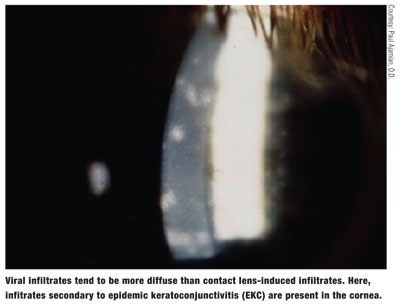
Q: I sometimes have trouble determining the cause of a red eye response in a contact lens wearer, especially since an adenoviral infection can mimic contact lens-associated red eye with infiltrates. How can I best determine whether an acute conjunctivitis with infiltrates in a contact lens wearer is viral, lens related or due to another cause?
A: You would approach this patient as you would any other, starting with the patients history. Youll see a history of progressive contact lens intolerance in contact lens-induced patients over a period of a few months, as opposed to the viral conjunctivitis, which is very rapid in onset, says Stephen Pascucci, M.D., of
Clinical signs of an adenoviral infection include tearing, serous discharge, edematous eyelids and pinpoint subconjunctival hemorrhages.1 The lashes will often look pointy as well.
Typically, you also hear about a history of lids sticking, Dr. Pascucci says. When the patient wakes up, the lids are matted together, which is more consistent with viral conjunctivitis than it is [with] contact lens-induced keratitis. Also, with a viral cause, a patient will sometimes suffer upper respiratory effects. That doesnt happen frequently, but it can be seen in a case history and would imply a viral etiology.

Another way to determine the type of infection is to find its source. Adenoviral infections are highly contagious and demonstrate high rates of survival in sterilization systems.1-3 They can be transferred from person to person or even through a multi-use eye drop bottle.1,2 Contact with someone with viral conjunctivitis would also be evident in the history of a viral infection, Dr. Pascucci says.
Unlike viral cases, contact lens-induced inflammation presents without any such outside influences.
On examination, contact lens-induced inflammation and adenoviral conjunctivitis present slightly differently. Patients who have viral conjunctivitis typically present with preauricular lymphadenopathy. If you feel the patients skin, you can very commonly feel a lymph node, which many times for the patient is tender. That is much more indicative of a viral situation, Dr. Pascucci says.
Contact lens problems typically dont present with a node, and
adenovirus often does, adds Paul Ajamian, O.D., of Omni Eye Services in
Also, patients who have viral conjunctivitis present with follicles on the conjunctiva, Dr. Pascucci says. By contrast, contact lens-based inflammation will not irritate the conjunctiva as badly.
During the exam, youll need to evert the upper and lower lids. Make sure that there is nothing underneath the eye, Dr. Ajamian says. When you evert the upper lid, you may see membranes or pseudomembranes. They are very painful and often require therapy. These, he says, signal adenovirus.
Adenovirus and contact lens-related inflammation both present with infiltrates, although these do not appear immediately with adenoviral conjunctivitis. Contact lens-induced conjunctivitis, however, presents with rapid-onset multiple corneal infiltrates. The cornea should not be involved in adenovirus until day seven to day 10, Dr. Ajamian says.
Also, viral infiltrates are more diffuse, while contact lens-induced infiltrates are more sectoral. Classic adenovirus infiltrates are subepithelial and typically in the central cornea, Dr. Ajamian says. Contact lens infiltrates take on many forms. Theyre often marginal, around the limbus. They can be in the form of multiple focal infiltrates or sometimes as a diffuse infiltrative haze that can be mistaken for corneal edema. Or, you can have a rather large infiltrate in the central cornea.
One diagnostic tool that could help is the Adeno Detector RPS (Rapid Pathogen Screening).4 Using the testing tool, you collect a fluid sample from the lower conjunctiva and, within 10 minutes, the testing apparatus provides a positive or negative result for adenovirus. A one-year FDA study found that RPS has a positive predictive rate of 78% and negative predictive rate of 96%, and that it does not produce a false positive in the presence of other causes of conjunctivitis, such as Staphylococcus aureus, herpes or Haemophilus influenzae.4,5
When a contact lens patient presents with inflammation, be sure to rule out other possible diagnoses, such as uveitis. Sometimes, especially with contact lens-induced keratitis, youll see a secondary iritis or inflammation in the anterior chamber, Dr. Ajamian says.
Consider the possibility of herpetic eye disease whenever a corneal lesion doesnt fit the pattern of a contact lens or adenoviral infection. Keep herpetic eye disease in the back of your mind, and dont miss a dendrite, especially if the infection is unilateral, Dr. Ajamian says. Contact lens problems are usually asymmetric, adenovirus eventually affects both eyes, and herpes is almost always just one eye.
1. Sowka J, Gurwood AS, Kabat AG. Pharyngoconjunctival fever, epidemic keratoconjunctivitis. In: Handbook of Ocular Disease Management. Rev Optom 2000 Aug: Supplement: 17A-18A.
2. Uchio E, Ishiko H, Aoki K, Ohno S. Adenovirus detected by polymerase chain reaction in multidose eyedrop bottles used by patients with adenoviral keratoconjunctivitis. Am J Ophthalmol 2002 Oct;134(4):618-9.
3. Kowalski RP, Sandar-Raj CV, Romanowski EG, Gordon YJ. The disinfection of contact lenses contaminated with adenovirus. Am J Ophthalmol 2001 Nov;132(5):777-9.
4. Gurwood AS. A rapid test for red eye. Rev Optom 2006 May;143(5):116-7.
5. Rapid pathogen screening. Point-of-care diagnostic services adeno detector instructional insert. RPS Insert 2006:1-2.

